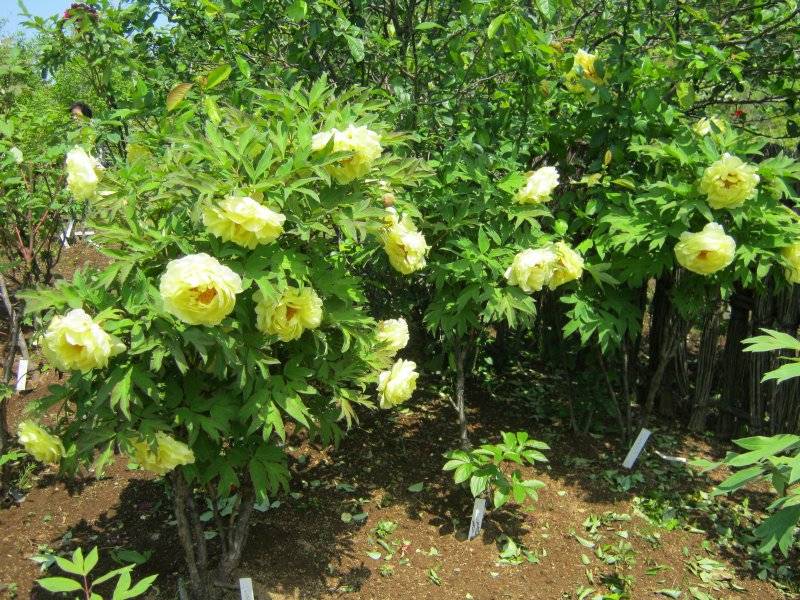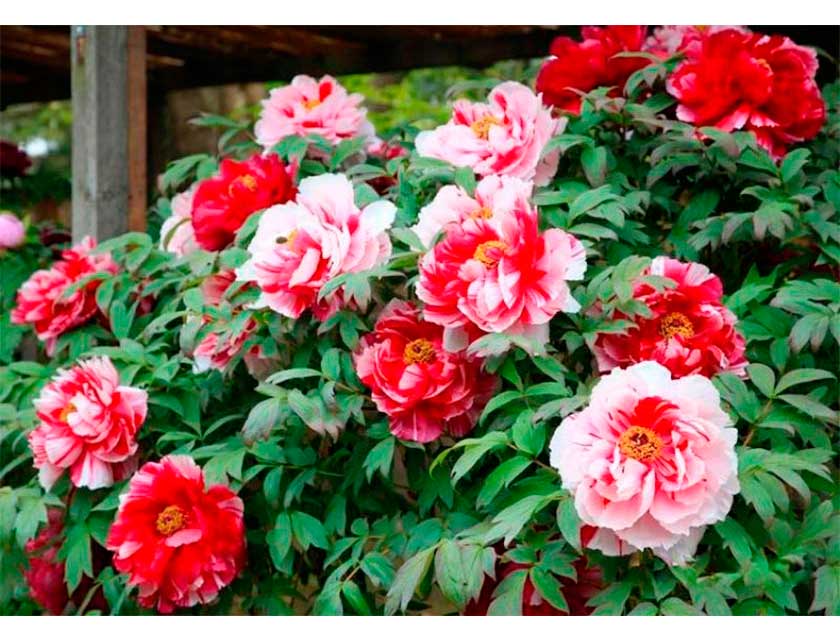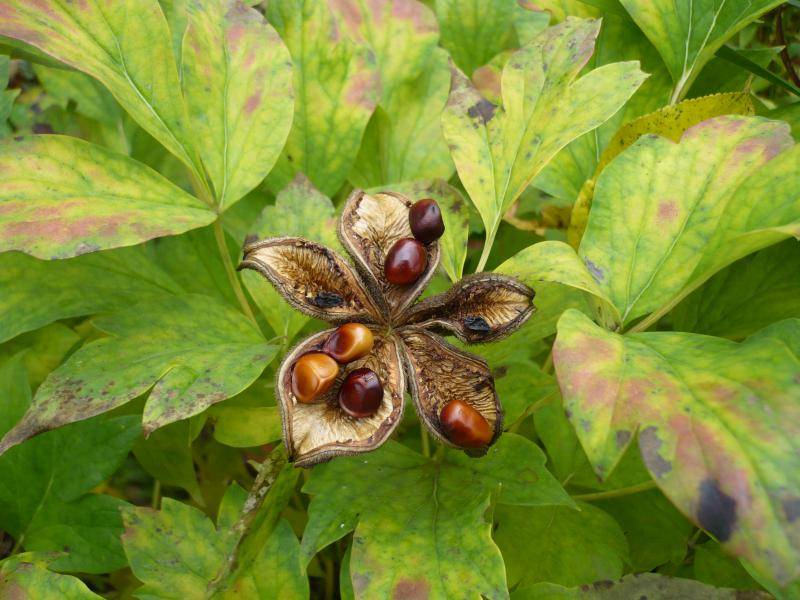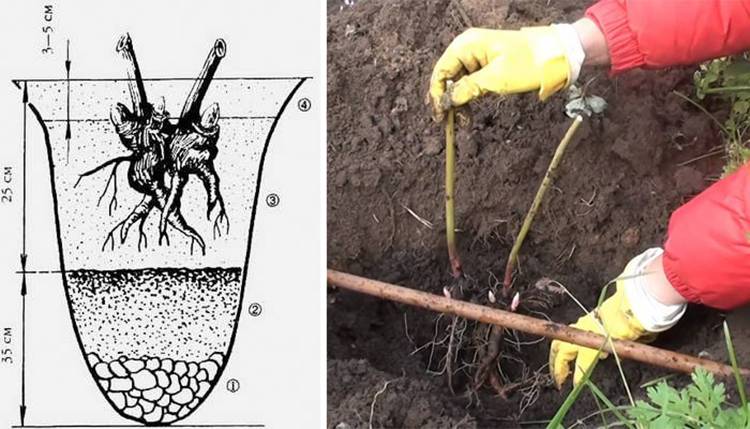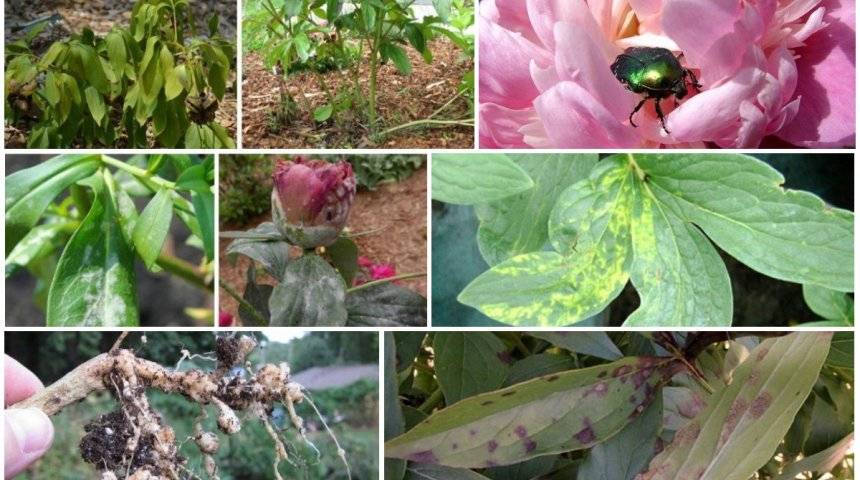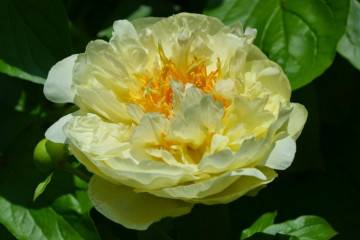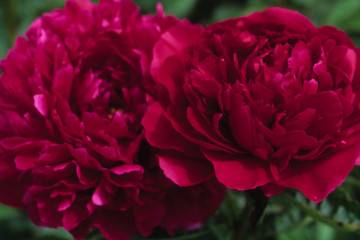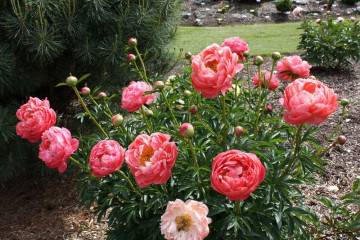Tree peony - description of the species, the best varieties for the garden
Content:
The plant is ideal for decorating a home garden plot, parks, flower beds, Japanese gardens. Bush peonies are spectacular and presentable. Looks great in the background.
Tree peony: what kind of species it is, history of creation
The plant is a shrub up to 1.5 meters high with light brown stiff stems, on which there are leaves, and at the top is a single flower 10-25 cm in diameter. The petals are usually white, pink, red or yellow.
The plant is a close relative of the herbaceous peony, but it has differences:
- a tough stem-branch that does not die off for the winter;
- grows in one place up to 100 years;
- the shoots of the tree peony are cut off, leaving 10-15 cm from the root, and every year they spud before wintering;
- grows slowly, the first flowers appear when the peony gets stronger;
- the stems do not sag under the weight of the flower.
In the wild, it is distributed in China, Japan, Korea, Tibet, and the Far East. The Chinese call it the imperial flower and have been growing it for over 2 thousand years. It was brought to Russia in the middle of the 18th century as a subtropical plant. Every year, with the arrival of cold weather, it was dug out of the open ground and transplanted into the covered greenhouse of the Imperial Botanical Garden in St. Petersburg. Until in 1941, before the blockade of Leningrad, for some reason, they did not. The peony was simply sprinkled with earth and leaves. He overwintered, survived and gave a riotous color.
Classification
Science knows about 500 varieties of wood peony. They are grouped into three groups:
- Sino-European - have large double heavy flowers: white, pink, coral, red, purple-purple, white-red. Names - Sapphire, August Dessert, White Wanderer, Kiao Sisters, Purple Lotus;
- Japanese - are distinguished by modest simple or semi-double flowers: white, light green, pale purple. They are strict, light, laconic. These are Kochonomi, Koshinoyuki, Green Beans, Green Jade;
- hybrid - have a rare yellowish color of buds, sometimes with a red edging or spot inside. This is Lollipop, Souvenir de Maxime Cornu, Age of Gold.
The varieties most in demand among gardeners
The Qiao sisters
Unpretentious, disease- and frost-resistant variety up to 2 meters high. The flowers are white-pink with a diameter of up to 25 cm. It opens for 2 weeks.
Kinko
The petals are bright lemon-colored with pink edging. The diameter of the flowers is 18-20 cm. The plant itself is up to 1 meter in height. Grows well. Suitable for single and group plantings. Resistant to cold and disease. Blooms in May-June.
Blue sapphire
It has large pink-purple flowers up to 25 cm in diameter. Peony stems are thin and low, so they are tied up. The plant is unpretentious.
Red giant
Up to 1.5 meters high with red crown flowers up to 16 cm in size. It blooms in June. Frost resistant. Feels good in the sun.
Green beans
Up to 90 cm high with light green double inflorescences with a diameter of 17-20 cm and a weak aroma. The variety is resistant to disease and frost.
Coral altar
Has coral pink toothed hollow flowers. The aroma is sweetish. Dissolves in June for 15 days. Grows in sunny fertile areas.
White wanderer
Up to 1.5 meters high. In mid-June, on erect stems, rich white crown inflorescences with a diameter of 15 cm are formed.
Growing a flower, how to plant it in open ground
For perennial flowering of the tree peony, proper care and cultivation are important. It should be planted in sunny, spacious areas protected from the wind. There should be no tall spreading trees, bushes, buildings, houses nearby. It is desirable that in the midday heat the plant is in partial shade. The distance between seedlings is at least 1.5 meters.
If the seedling has an open root system, the optimal cultivation time is September. Peonies in pots with a closed root system are planted in spring (April, May), autumn (September) and even summer (August). For a peony to take root well, a month must pass before the first frost.
Breeding methods:
- By division. A 5-6 year old plant is suitable for this. In September, it is dug up and divided for breeding into small bushes, in which there are at least three shoots. Places of separation are treated with charcoal and placed in a solution of clay and water for 30 minutes.
- Cuttings. In summer, semi-lignified shoots with buds and leaves are cut off and placed in a peat substrate. They are covered with plastic caps and watered regularly. After 2-3 months, the root system develops in the shoots. They are transplanted into pots and stored until the arrival of heat.
- Layers. In May, the shoot is pressed to the ground with staples and sprinkled with earth. After 2-3 months, the buried part gives rise to root processes. It is separated and transplanted into a separate place.
- Seeds. Growing a peony from a seed is within the power of breeders in the laboratory. First, the highest quality fresh seeds are selected. They are treated with heat and cold. They germinate in the 2nd year of life. Such a peony blooms 5-7 years after planting.
Preparing the soil and tree peony seedlings before planting:
- For 7-10 days, a planting hole is dug 60 cm deep and the width of the plant's root system, but not less than 50 cm.
- Arrange drainage to a height of 20-30 cm from crushed stone, expanded clay, small stones.
- If the soil is loamy or sandy, add peat, humus, turf.
- Add 200 grams of lime to the acidic soil.
- Inorganic fertilizers are introduced: 30 grams of superphosphate and 20 grams of potassium sulfate.
- Examine the root and shoots for damage, disease and pests. Diseased shoots are discarded and cut off.
- Roots are soaked in a growth promoter for 20-30 minutes.
When the preparatory stages are over, the plant is planted:
- Gently straighten the root system.
- The seedling will be hindered in the planting hole.
- The root collar and buds of renewal are sprinkled with earth, so that they are at a depth of 3-5 cm from the soil surface. This will provide them with frost protection and proper plant development.
- The voids between the roots are sprinkled with peat, earth, lightly tamped, watered and mulched with humus.
- If the seedling is in a pot, it is transplanted together with an earthen clod.
Caring for tree varieties
Peony needs watering and fertilizing with mineral fertilizers. An adult plant, before and during the blooming of buds, is watered once every 10-14 days, using 8-10 liters of water per plant. After that, the frequency of watering is reduced to 1 time per month. The water should not be icy.
The next day after watering, it is imperative to loosen the soil around within a radius of 50 cm to a depth of 5 cm to enrich the soil with oxygen and fight weeds.
Feeding with phosphorus and potash fertilizers is carried out every 15 days. The first fertilizers are applied in April 2 weeks before blooming, and the last ones - 10 days after. In order for healthy strong buds to ripen for next year, the peony should be fed back in August.
Blooming tree peonies
The grafted seedlings delight with the first flowers the next year. Peonies with their own root system grow slowly and begin to bloom for 4-5 years. The beginning of flowering depends on the climate and the variety. In the southern regions it is May-June, in the northern regions it is June-July.
During this period, the bush is looked after, regularly watered and applied with potash and phosphorus fertilizers. To prevent the branches from bending under the mass of inflorescences, they are carefully tied to a support. At rest, the frequency of watering is reduced, dried buds are cut off.
It so happens that a peony does not bloom for several years. The reasons are different and the solutions are also:
- planted in a shaded place, close to buildings and tall trees - replanting a peony or pruning neighboring trees;
- acidic soil - add dolomite flour or lime;
- high soil moisture - equip drainage, add sand;
- improper deepening of the root collar - transplanted;
- peony disease - treated with antifungal drugs, transplanted in the sun;
- poor air exchange in the soil - it is loosened and weeded.
Peonies after flowering
After flowering, the following procedures must be carried out.
Transfer
The transplant is carried out in August-September. The plant tolerates this procedure painfully. Some branches are drying up, but don't panic about this. They are cut, and in April young buds appear, giving new shoots.
Dry, diseased roots are removed from the dug plant. The sections are treated with activated carbon.
Pruning
In September, the upper shoots with seeds and peduncles are removed to the first bud.
The main pruning is carried out in March-April after the awakening of the kidneys. Dead, dried branches are cut at the root. Strong - up to the first bud, and weak - up to 10 cm from the soil surface.
Preparing for winter
When the first frosts appear, the shortened shoots are neatly not tightly tied with wire, twine and covered from snow drifts with spruce branches, burlap, lutrasil.
Diseases, pests and ways to control them
Improper care, prolonged rains, sudden temperature changes, insects harm the plant. In the absence of prophylaxis, it becomes ill.
The table provides a description of the most common diseases and pests
| Name | Cause | Signs | Ways to fight |
| Rust | High humidity + heat, rust fungus spores | Small brown, reddish spots with a brown border |
|
| Gray rot | High humidity + low temperature, insect-borne | Brown spots at the base of the shoots, on leaves, buds, flowers of irregular shape and open to one side. The disease enters the root |
|
| Root rot | Frequent watering and waterlogging of the soil, high acidity of the soil | The roots turn brown, become soft. A gray or pinkish coating appears. |
|
| Ring mosaic | Insect infestation, inventory | Leaves are covered with light green stripes, spots |
|
| Aphid | It settles on the buds in large numbers | Treatment with soapy water, insecticides. | |
| Gall nematodes | They spoil the roots, forming knots on them. The plant withers and dies completely. |
|
|
| Ants | They eat petals, leaves of buds. | Repellent treatment. |
Grown with care and love, the tree peony is the adornment of any home garden for many years. It can be combined with any ornamental plants and evergreen shrubs.
This is a great solution for landscaping.
